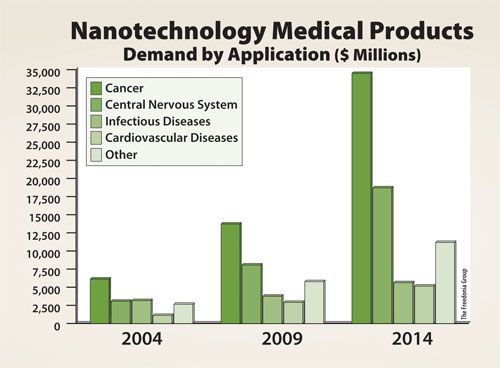October 15, 2010 (Vol. 30, No. 18)
Small Drugs, Diagnostics, Medical Supplies, and Devices Pack a Considerable Punch
Demand for nanotech medical products will increase over 17% per year until 2014, when we estimate the market for these products will reach $75.1 billion. Afterward, the increasing flow of new nanomedicines, nanodiagnostics, and nanotech-based medical supplies and devices into the U.S. marketplace will boost demand to $149 billion by 2019.
The critical need for new or improved therapies for many medical conditions will promote the application of nanotechnology to an expanding number of pharmaceuticals. The total market for nanomedicines will command strong growth over the long term, rising to $59 billion in 2014 and sustaining a strong upward pace to $118 billion in 2019.
Treatments based on humanized and fully human monoclonal antibodies and, to a lesser extent, nanopolymers and crystalline nanoparticles, will also drive gains. Therapies for advanced cancers, autoimmune diseases, neurological disorders, and viral infections will lead new product introductions and command the strongest growth opportunities. Gradually, nanomedicine application will extend into all major therapeutic classes, encompassing numerous formulations and delivery systems.
Advances in nanotechnology are also contributing substantial improvements to the quality and performance of diagnostic products. Immunoassays based on monoclonal antibodies and DNA probes are greatly enhancing the speed, accuracy, capabilities, and cost-effectiveness of in vitro diagnostic testing, drug discovery, and medical research procedures.
Nanoparticle formulations of superparamagnetic iron oxide, gadolinium, perfluorocarbon, and specialty polymers will broaden in vivo imaging capabilities by enabling the detection of tumors, plaque, genetic defects, and other disease states at much earlier stages and with lower and safer concentrations of injected compounds.
Reflecting anticipated performance advantages over existing products and an expanding range of new commercial offerings, demand for nanodiagnostics is projected to increase 6.8% per year to $11.3 billion in 2014 and continue rising at a good clip to $15.3 billion in 2019.
Several medical supplies and devices will provide key applications for nanotechnology. Nanomaterials are already realizing significant demand as active ingredients in burn and wound dressings, bone substitutes, dental repair, and restoration products.
In the longer term, advances in nanotechnology will lead to the introduction of new, improved medical supply and device coatings as well as a new, diverse group of medical implants with nanosensor components.
In 2014, demand for medical supplies and devices based at least partially on nanomaterials, is projected to reach $5.1 billion, up from $530 million in 2009. This amount will more than triple by 2019 as nanosensors, nanofibers, and nanopolymers broaden their penetration of applications in medical implants, surgical supplies and devices, and wound closures.
The greatest near-term impact of nanotechnology in healthcare will be in therapies and diagnostics for cancer and central nervous system disorders. Gradually, many other major diseases, as well as injuries, will be treated and detected routinely by products based on nanosized ingredients or components. Advances in nanotechnology will also expand capabilities in the areas of drug discovery, surgery, and general medical research.

Nanotechnology medical products, demand by application ($ millions)
Bill Martineau is an analyst at The Freedonia Group. Please contact Corinne Gangloff at [email protected] with any questions.



